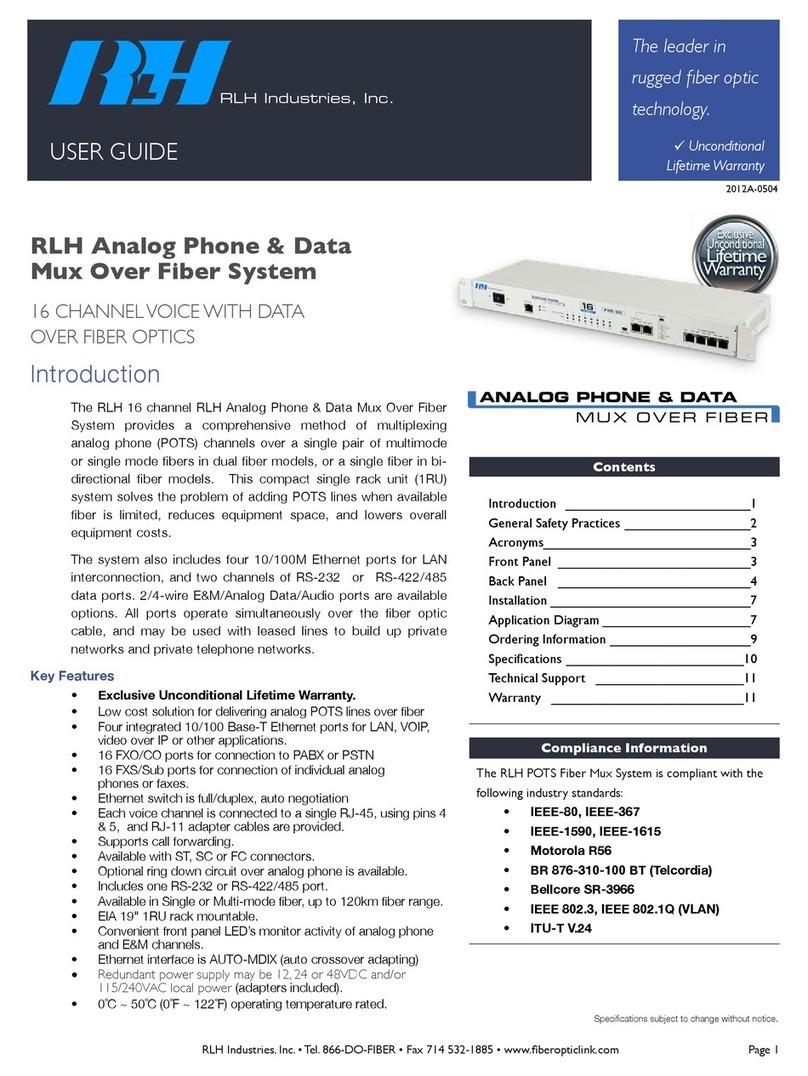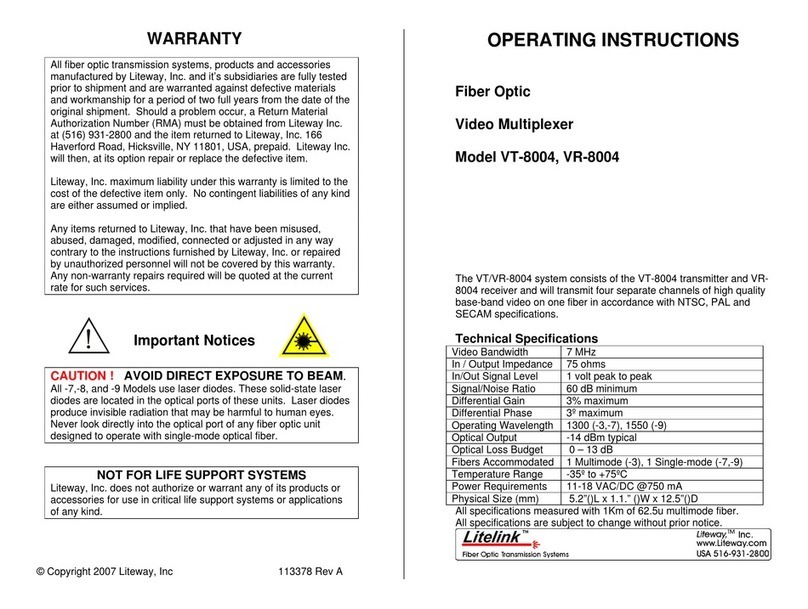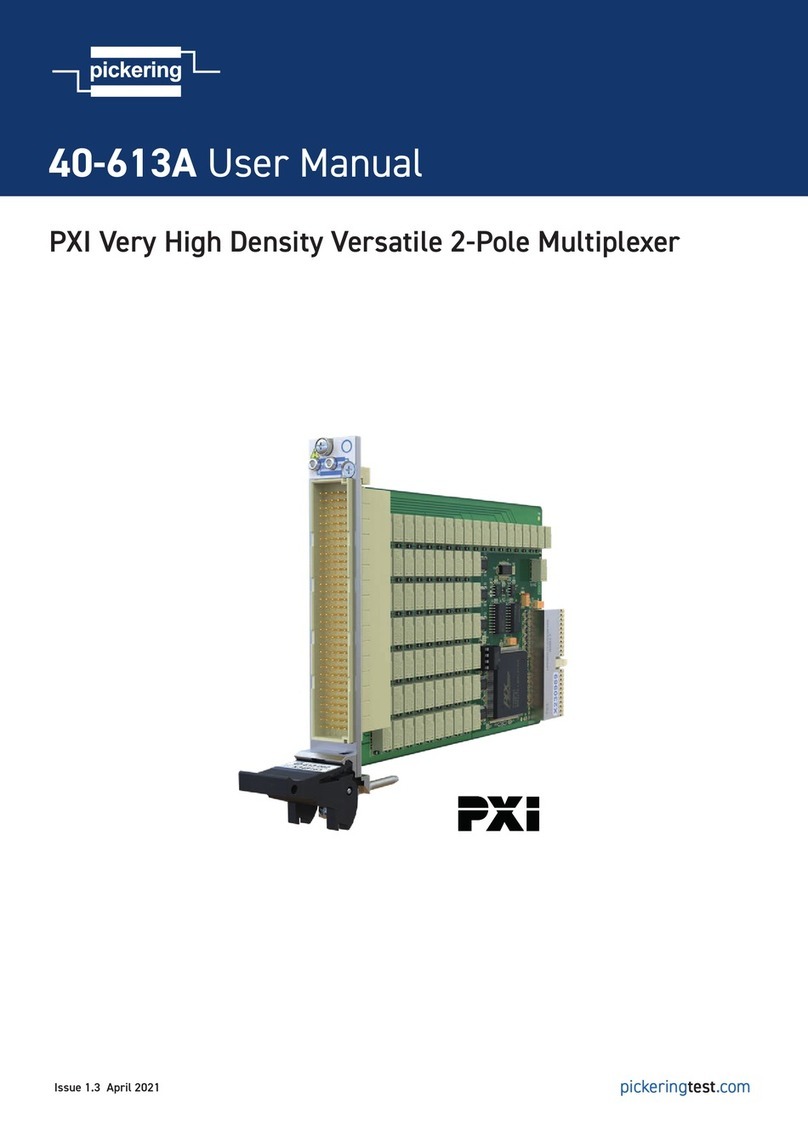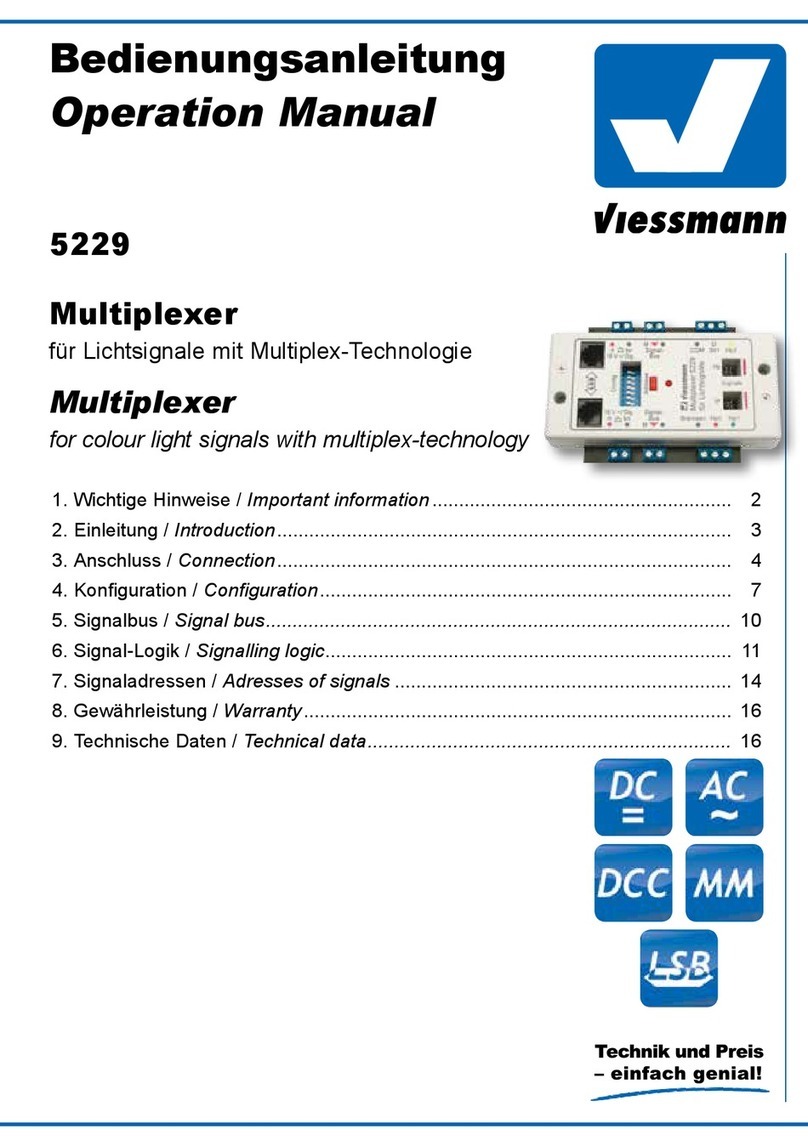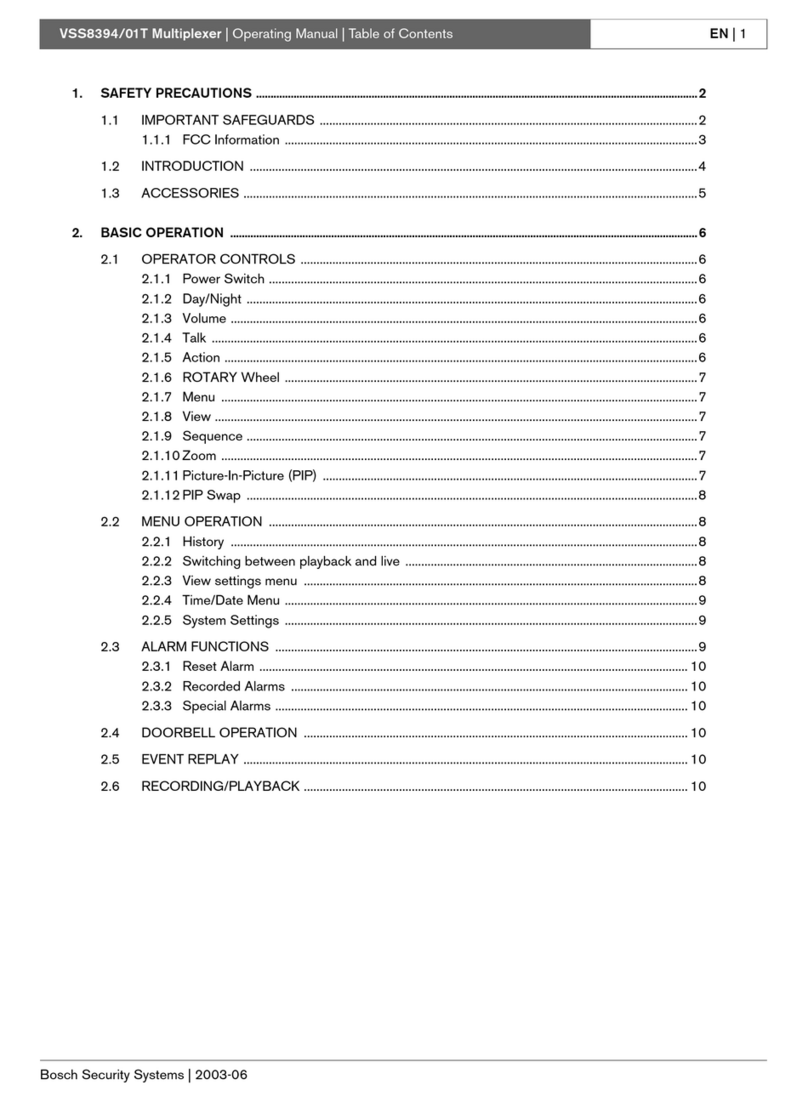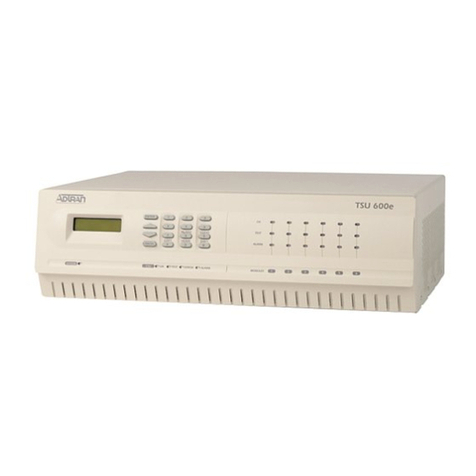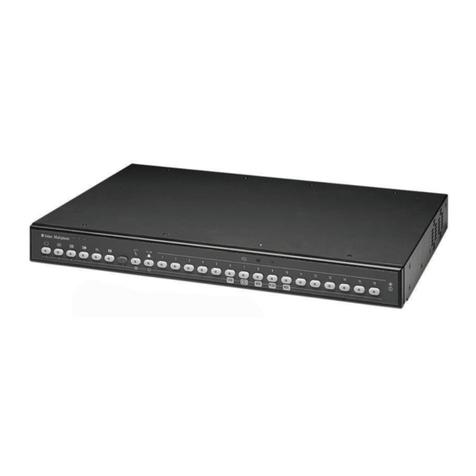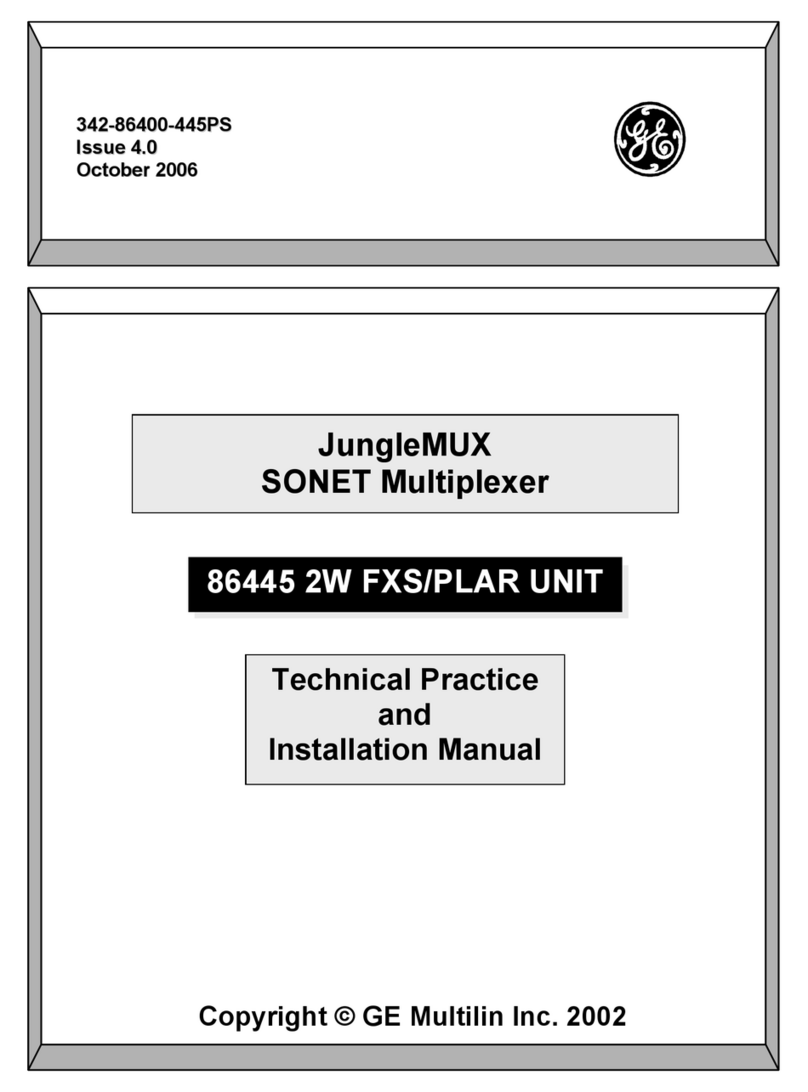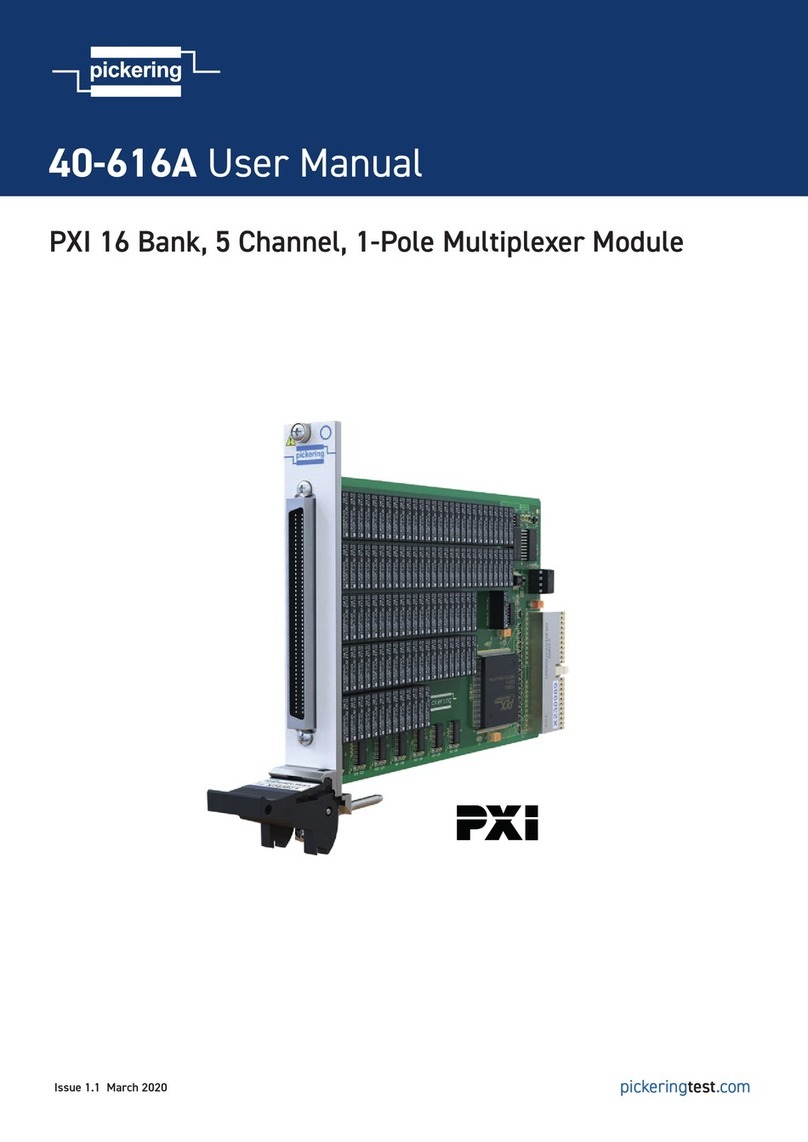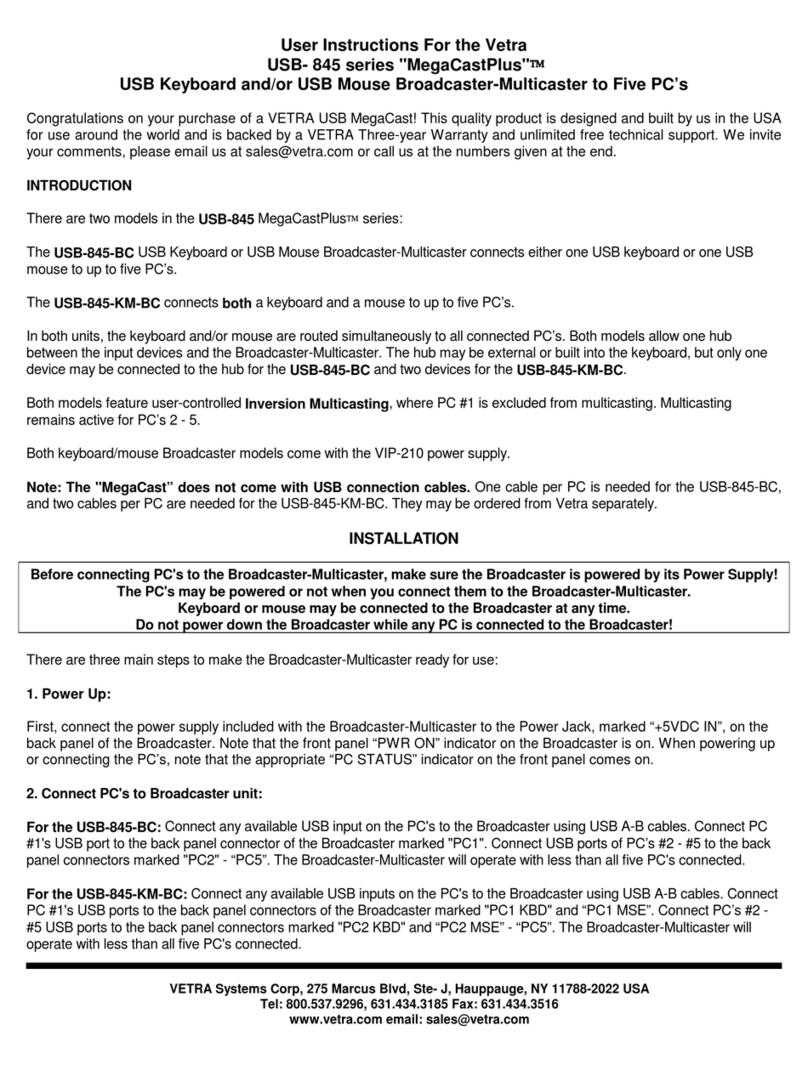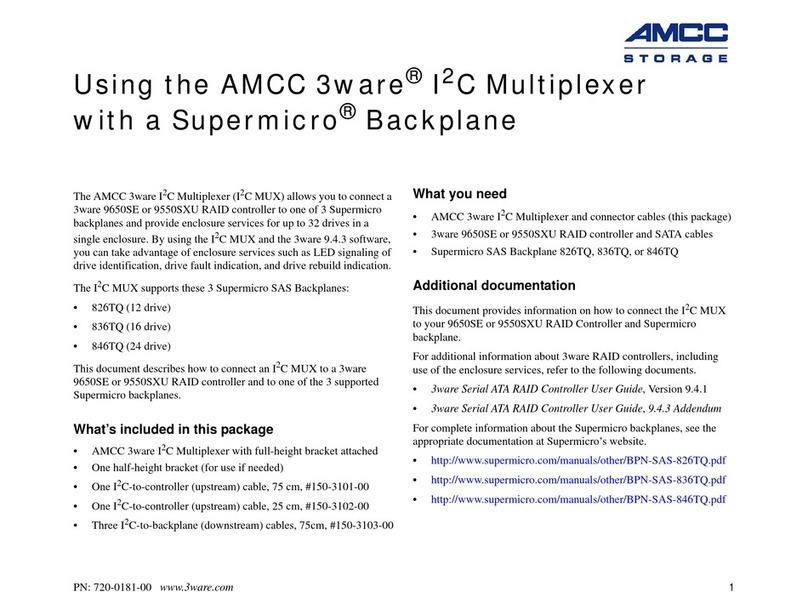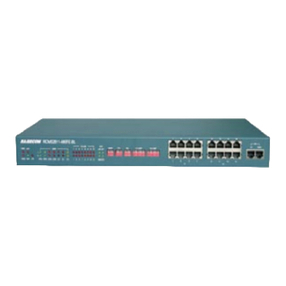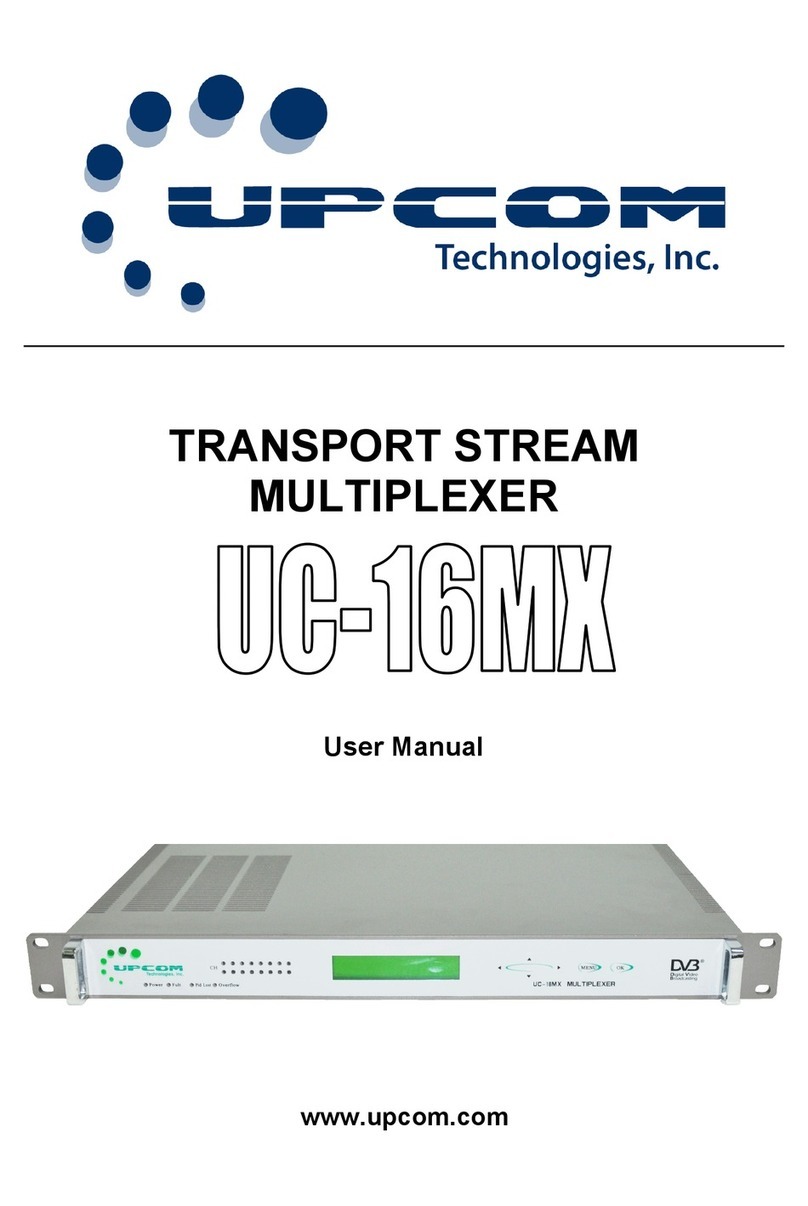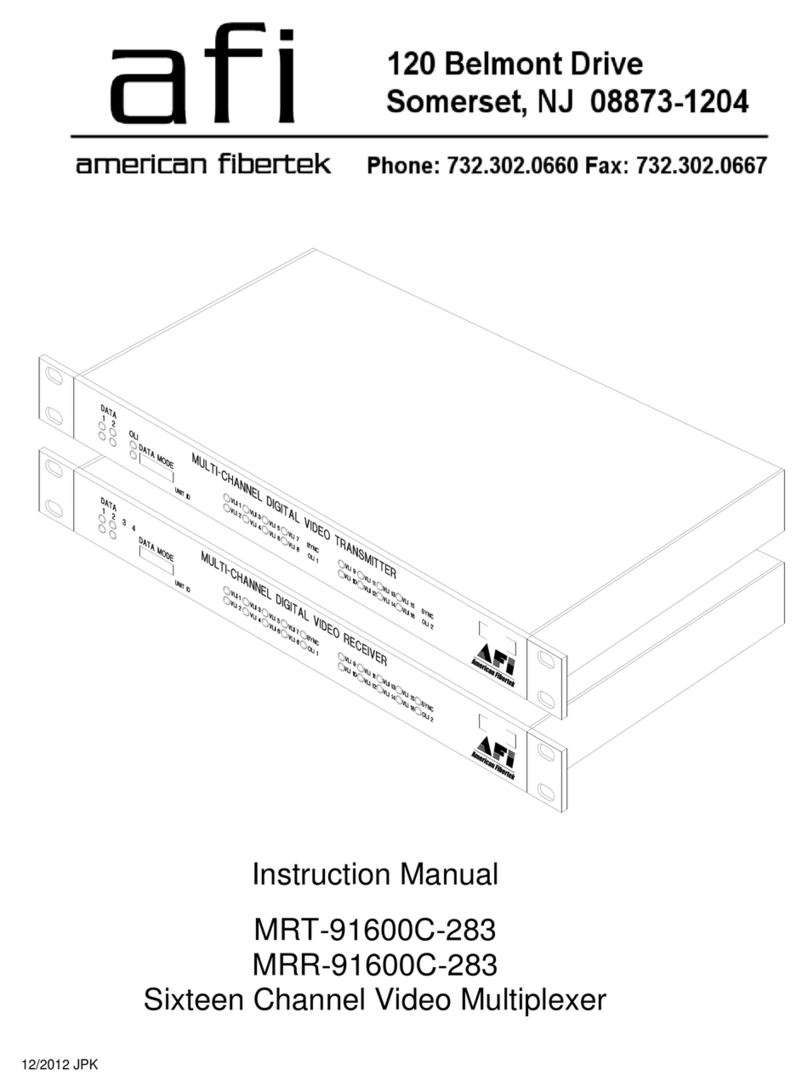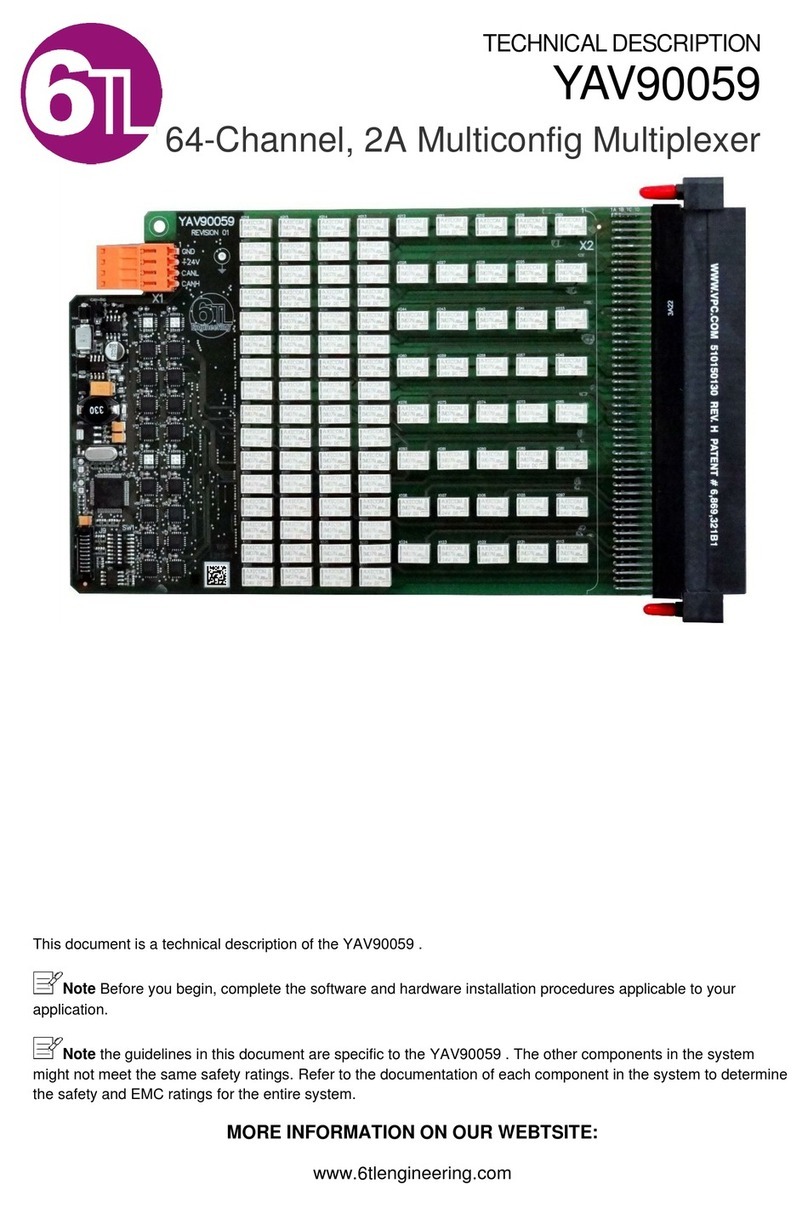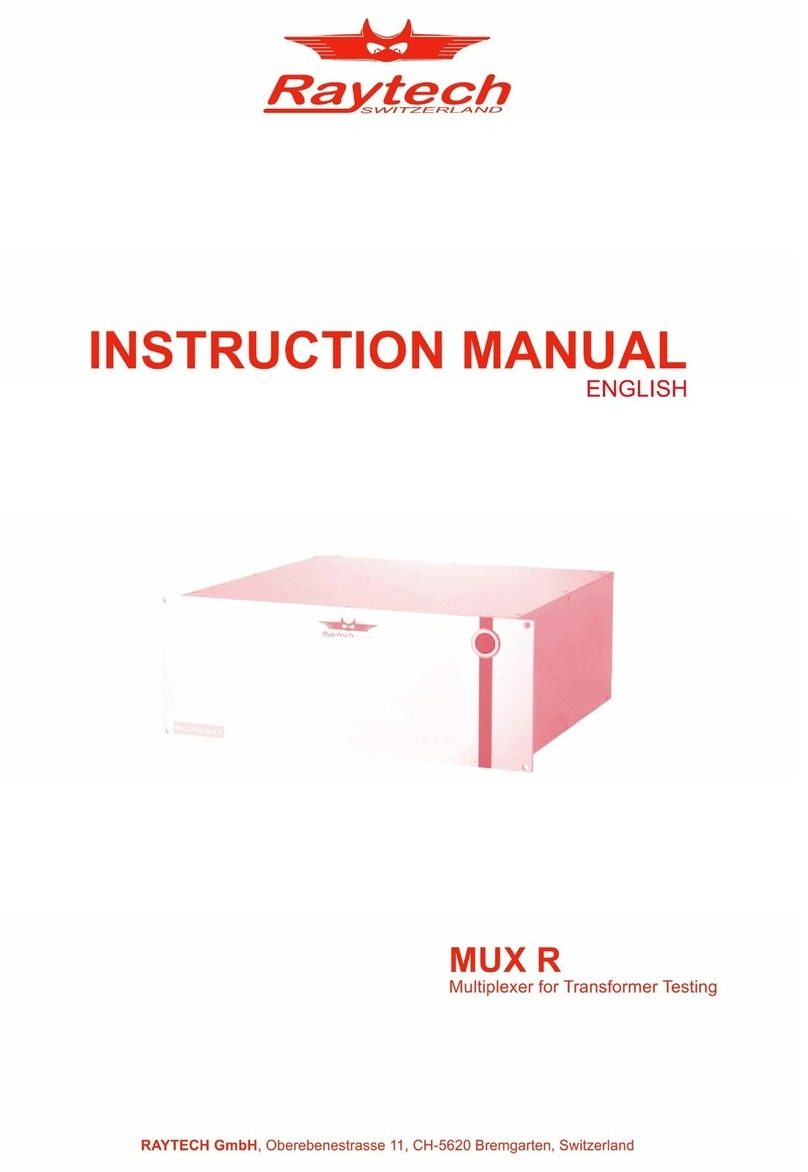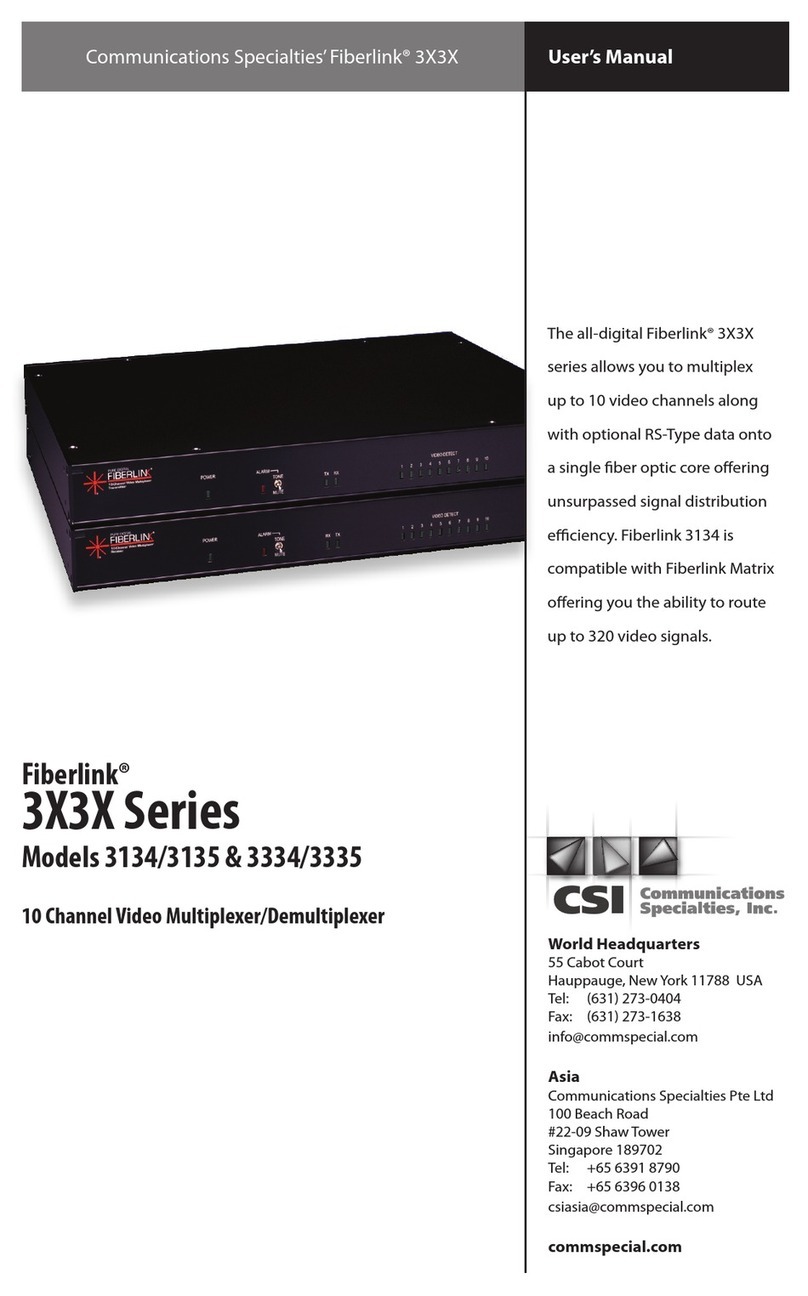RLH Industries 16 Channel T1 Over Ethernet Multiplexer... User manual

16 Channel T1 Over Ethernet
Multiplexer System
User Guide
RLH Industries, Inc.
2010B-1029

RLH Industries, Inc.
Copyright © 2010 RLH Industries, Inc. All rights reserved.
No part of this document may be copied or distributed without
permission.
The RLH logo may not be used for commercial purposes without
the prior written consent of RLH and may constitute trademark
infringement.
Other company and product names mentioned herein are
trademarks of their respective companies. Mention of third-party
products is for informational purposes only and constitutes neither
an endorsement nor a recommendation. RLH assumes no
responsibility with regard to the performance or use of these
products.
The information contained in this document is the property of RLH
Industries, Inc. and my not be reproduced or disseminated to third
parties without the express written permission of RLH.
Every effort has been made to ensure that the information in this
manual is accurate. RLH is not responsible for printing or clerical
errors. Because we are constantly seeking ways to improve our
products, specifications and information contained in this
document are subject to change without notice.
RLH Industries, Inc.
936 North Main Street
Orange,CA 92867
Ph. 714 532-1672
email: info@fiberopticlink.com
www.fiberopticlink.com
!

1. Important information
General Safety Practices 4
Special handling requirements 5
Acronyms 6
2. General Information
Overview 7
RLH 16 Channel T1/E1 over GE Features 7
Applications 8
Network Integration 8
Fiber Optic Isolation 9
Timing modes 10
Timing Mode Reference Table 10
2. System Architecture
Block Diagram 11
Functional Description 11
3. Components
Interior Layout 12
Front panel 12
LED’s 13
Dip Switches 14
T1/E1Port Connections 15
RJ-45 male pins chart 15
RJ-45 female pins description for CO side units 15
RJ-45 female pins description for Sub side units 16
Ethernet ports 16
Power 16
Contents
Contents!RLH Industries, Inc. - 16 Channel T1/E1 over GE with Fiber!1

4. Installation
Mechanical 17
Physical dimensions 17
Electrical 17
Power connections 17
E1/T1connections 18
Ethernet/fiber optic connection 19
5.Troubleshooting
E1/T1 Alarm LEDs on 20
Lnk/Act LED off 20
Ready LED does not blink 20
Cannot set up T1/E1channel 20
Downstream reporting slips 21
6.Web Manager
Show current status menu 22
Configuration 23
Service configuration and parameters 23
Ethernet management parameters 24
E1/T1 service management parameters 25
VLAN management 27
VLAN Management parameters 28
Service configuration indication 28
Network configuration 29
Webserver online upgrading 30
Upgrade Web management software 31
Upgrade the application software 31
Upgrade hardware program 32
System reboot 33
Contents
2!RLH Industries, Inc. - 16 Channel T1/E1 over GE with Fiber!Contents

7. Ordering Information
16 Channel T1 over Ethernet Multiplexer System 34
SFP Optical Transceivers 34
Replacement/Spare T1 modules 35
Replacement/Spare Power Supplies 35
8. Specifications
9. Support
Warranty 37
Technical Support 37
Contact Information 37
Contents
Contents!RLH Industries, Inc. - 16 Channel T1/E1 over GE with Fiber!3

1."Important information
Intended Audience
This guide is intended for use by knowledgeable telco/network installation, operation and repair
personnel. Every effort has been made to ensure the accuracy of the information in this guide is
accurate. However, due to constant product improvement, specifications and information contained in
this document are subject to change without notice.
Conventions
Symbols for notes, attention, and caution are used throughout this manual to provide readers with
additional information, advice when special attention is needed, and caution to prevent injury or
equipment damage.
Notes: Helpful information to assist in installation or operation.
Attention: information essential to installation or operation.
Caution: Important information that may result in equipment damage or injury if ignored.
General Safety Practices
The equipment discussed in this document may require tools designed for the purpose being described.
RLH recommends that service personnel be familiar with the correct handling and use of any installation
equipment used, and follow all safety precautions including the use of protective personal equipment as
required.
Caution - Severe Shock Hazard
• Never install during a lightning storm or where unsafe high voltages are present.
• Active T1 lines carry high DC voltages up to 56V. Use caution when handling T1 wiring.
Warning
The intra-building port(s) of the equipment or subassembly is suitable for connection to intrabuilding or
unexposed wiring or cabling only. The intra-building port(s) of the equipment MUST NOT be metallically
connected to interfaces that connect to the OSP or its wiring. These interfaces are designed for use as
intra-building interfaces only (Type 4 ports as described in GR-1089-CORE, Issue 4) and require isolation
from the exposed OSP cabling. The addition of Primary Protectors is not sufficient protection in order to
connect these interfaces metallically to OSP wiring.
4!RLH Industries, Inc. - 16 Channel T1/E1 over GE with Fiber!Important Information

Special handling requirements
Be careful when handling electronic components
ATTENTION
ELECTROSTATIC
SENSITIVE
DEVICES
• This product contains static sensitive components.
• Do not open the enclosure, there are no user serviceable parts.
• Follow proper electrostatic discharge procedures.
This product utilizes circuitry that can be damaged by static electricity. Before installing, discharge static
electricity on your body by physically making contact with earth ground. Failure to follow ESD
precautions may cause damage to the unit and prevent proper operation.
Guidelines for handling terminated fiber cable
• Do not bend fiber cable sharply. Use gradual and smooth bends to avoid damaging glass fiber.
• Keep dust caps on fiber optic connectors at all times when disconnected.
• Do not remove dust caps from unused fiber.
• Keep fiber ends and fiber connectors clean and free from dust, dirt and debris. Contamination will cause signal
loss.
• Do not touch fiber ends.
• Store excess fiber on housing spools or fiber spools at site
Important Information!RLH Industries, Inc. - 16 Channel T1/E1 over GE with Fiber!5
• Verify or repair before continuing

Acronyms
Commonly used acronyms and abbreviations
Acronym/Abbreviation
Description
B8ZS
Bipolar 8 Zero Substitution
AMI
Alternate Mark Inversion
CFJ
Copper Fiber Junction (also referred to as Demarc)
CO
Central Office
CPE
Customer Premises Equipment
Demarc
Location of RLH CO equipment and Telco connection
GPR
Ground Potential Rise
LED
Light Emitting Diode
Sub
Subscriber
NIU
Network Interface Unit
RX
Receive
TX
Transmit
Color abbreviations
Abbreviation
Color
BLU
Blue
GRN
Green
ORG
Orange
RED
Red
YEL
Yellow
6!RLH Industries, Inc. - 16 Channel T1/E1 over GE with Fiber!Important Information

2."General Information
Overview
Thank you for selecting the RLH 16 Channel T1/E1 over IP/Ethernet multiplexer. This modular
multiplexer unit can be used to provide T1/E1 communication channels over Ethernet or IP networks.
The RLH 16 Channel T1/E1 multiplexer has many optional parameters, that can be modified by the user
to suite different application requirements. Please read this guide carefully before installing the product.
It is well known that the T1/E1 signal comes from PCM technology which is TDM in nature. It transmits
information in a constant bit rate of E1 2048kbit/s, TDM technology occupies fixed transmission
bandwidth, with QoS features suitable for real-time applications such as voice and video. The QoS
features include short and stable transmission delay, low jitter and wander, etc.
On the other hand, Ethernet is based on statistical multiplexing, transmitting and exchanging information
in packets. It does not take up a fixed transmission bandwidth, which is good for achieving higher
bandwidth utilization. But Ethernet technology does not provide adequate QoS for real time applications.
Until recently, voice and data were, and still are to a large extent, transported over two separate
networks. But the requirement for both types of information to be carried over a unified network is
growing rapidly. Packets over SONET/SDH techniques to integrate data into the TDM network have
been around for many years. But for voice over packet based data networks, most of the efforts are
spent on creating special equipment that specifically packets voice or video signals, such as equipment
used for VoIP.
However, to take advantage of the data network, it is neither cost effective, nor necessary to replace all
TDM based equipment with new packet based equipment. The RLH 16 Channel T1/E1 Mux can be used
to emulate transparent T1/E1 channels over an Ethernet with adequate QoS, so that most existing T1/
E1 based applications can be readily setup over Ethernet LANs and WANs. One such application is to
build T1/E1 links with low cost wireless LAN bridges, replacing much more costly microwave radios.
RLH 16 Channel T1/E1 over GE Features
• Provide 16 channels of T1/E1 over 1 a single Ethernet port.
• Provide 5 GE electrical ports and 1 GE optical port, 6 GE ports serve as network uplinks or users ports, any of the
5 GE electrical ports may act as an NM port
• Support Ethernet spanning tree protocol which enables normal work and protection in ring and mesh topology,
enabling very fast network protection
• User-friendly Web server supported for easy setup and maintenance, alarm log provided
•Support SNMP V1/V2 network management ␣Ethernet built-in layer 2 switch, support VLAN, comply with IEEE
802.3Q and 802.3ad, support 802.1P.
• Provide two pluggable T1/E1 cards, each card supports 8 channels
• Point to point and point to multipoint application
• Stable T1/E1 clock recovery, low jitter and wander
• Low processing delay for T1/E1 channels, high bandwidth usage efficiency
General Information!RLH Industries, Inc. - 16 Channel T1/E1 over GE with Fiber!7

• Resistant to packet loss, with PCM frame synchronization protection.
• User definable encapsulation packet size for different applications.
• Supports Ethernet encapsulation and UDP/IP protocol encapsulation.
• Supports VLAN settings for T1/E1 service and in band VLAN management.
• Jitter buffer resists packet delay variation (PDV).
• Local Ethernet port throughput limiting, assuring T1/E1 QoS
• 120Ωbalanced E1/T1 port, RJ-45 connector, support 75Ωunbalanced port through outside converting cable.
• Support cascade concatenate for more than 16 T1/E1 ports
• Software and hardware online upgrade
• Power supply redundancy
Applications
Network Integration
The 16 Ch. Mux. is used to transport up to 16 transparent E1/T1 channels over LAN or IP networks.
RLH-TG-2A-1
N*T1
FE/GE
PBX
BSC/RNC
TDM Mux
BTS/Node-B
N*T1 N*T1
N*T1
RLH-TG-2A-1
FE/GE
Typical Application in a Wireless Network
RLH-TG-2A-1
N*T1 FE/GE
PBX
BSC/RNC
TDM Mux
BTS/Node-B
N*T1 FE/GE
RLH-TG-2A-1 FE/GE
FE/GE
RLH-TG-2A-1
N*T1
N*T1
RLH-TG-2A-1
Metro/
Ethernet IP
Typical Application in a Wired Network
In the diagrams above, a pair of RLH-TG-2A-1 multiplexers create transparent E1/T1 channels over the
packet network, providing connections between the PBX and telephone exchange, or other terminal
devices. At the same time, computers talk to each other through the local Ethernet ports. This
configuration guarantees that the T1/E1 channels get higher priority over computer data for maximum
QoS.
8!RLH Industries, Inc. - 16 Channel T1/E1 over GE with Fiber!General Information

The most widely used application of the RLH-TG multiplexers is to set up point to point wireless T1/E1
links using low cost wireless LAN bridges. RLH-TG multiplexers can work with most LAN bridges on the
market. It may be necessary to adjust different parameters such as packet size and packet jitter
absorption buffer size for best operation for different LAN bridges.
Be aware that wireless LAN bridges have a very limited bandwidth. If Ethernet data is to be transferred
at the same time, its traffic must be restricted. Otherwise it will affect the T1/E1 packets. Since the LAN
bridges usually don’t have adequate QoS mechanism to guarantee the T1/E1 priority, it is strongly
recommended that the data traffic be routed through the device’s local data port.
Warning
When connecting to a wireless LAN bridge, the uplink Ethernet cable often connects to the outdoor unit,
posing danger to lightning strikes that can seriously damage the equipment. To protect the equipment
as well as people, surge protection devices with good earth connection is strongly recommended. Poor
earth connection may also hinder the operation of the Ethernet port, causing severe packet losses.
Fiber Optic Isolation
PBX/BSC/RNC
RLH-TG-2A-1 RLH-TG-2A-1
FIBER
CABLE
GPR 300V POINT
(GPR ZONE)
N*T1
COPPER
CABLE
FE/GE
HIGH VOLTAGE
TOWER OR
SUBSTATION
BTS/Node-B
Typical HVP Application
Network equipment in high voltage areas can be at risk due to Ground Potential Rise (GPR). In this
instance copper network cable referenced to a remote ground can become a path for high voltages
during a ground fault. Use of all-dielectric fiber optic cable instead of copper completely eliminates the
presence of a remote ground, which dramatically increases safety of personnel and reliability of
equipment. By utilizing GE fiber optic cable, the RLH-TG multiplexer provides absolute electrical
isolation between both ends of the network.
Copper twisted pair Ethernet is limited to 100m/328ft without extenders. Using fiber optic cable
provides long distance service up to 80km/50mi. without any additional equipment. Optical fiber is also
immune to EMI/RF interference, ground loops, and high voltage surges from lightning or ground faults,
and is ideal in electrically noisy environments such as near large power sources, electrical motors, and
radio communications equipment.
General Information!RLH Industries, Inc. - 16 Channel T1/E1 over GE with Fiber!9

Timing modes
To emulate a clear E1/T1 channel over a packet network, the RLH-TG Mux not only conveys data
stream content correctly from the source to the destination, but also passes timing. Packet networks do
not provide such built-in timing transparency mechanism as TDM networks do.$RLH-TG Mux uses its
proprietary algorithm to reconstruct the E1/T1 clock at the destination. The recovered clock is of very
high quality, with low jitter and wander. Typical frequency offset is within ±5ppm, and jitter is below
0.1UI. It can be adopted in most applications. This timing mode of rebuilding the E1 clock at the
destination is called Adaptive Timing.
For applications where separate clock distribution network exists, another timing mode, Loop back
Timing, may be used for maximum clock quality.
The two timing modes of RLH-TG Mux are shown below.
!!!!!!!!!!!!!!!!!!!!!!!!!!"#$%&#$'!($)*+,-!.,--)%'+$/',%!012'+1!.,34!5/*!!!!!!!!!!!!!
!"#$%&$"' ()*+$' ,-"$&' (,&&$(".' ",' "#$' ,/"0,,%' /&1"2' 3,.1&4' 0)&4$%' ",' +14#"&1&4'
."%15$.'"#)"'()&'.$%1,/.+6'0)7)4$'"#$'$8/137$&"9':,'3%,"$("'"#$'$8/137$&"').'
;$++').'3$,3+$2'./%4$'3%,"$("1,&'0$<1($.';1"#'4,,0'$)%"#'(,&&$("1,&'1.'."%,&4+6'
%$(,77$&0$09' =,,%' $)%"#' (,&&$("1,&' 7)6' )+.,' #1&0$%' "#$' ,3$%)"1,&' ,-' "#$'
!"#$%&$"'3,%"2'()/.1&4'.$<$%$'3)(5$"'+,..$.9' '
1.3 Timing modes
6,! 1-)7$/1! $! +71$8! 9:;6:! +#$%%17! ,218! $! <$+=1/! %1/>,8=4! /#1! (0?:@9:?AB! %,/!
,%7C! +,%21CD! *$/$! D/81$-! +,%/1%/! +,881+/7C! E8,-! /#1! D,)8+1! /,! /#1! *1D/'%$/',%4! F)/!
$7D,!<$DD1D!/'-'%&3!B$+=1/!%1/>,8=D!*,!%,/!<8,2'*1!D)+#!F)'7/?'%!/'-'%&!/8$%D<$81%+C!
-1+#$%'D-! $D! 60G! %1/>,8=D! *,3! ! (0?:@9:?AB! )D1D! '/D! <8,<8'1/$8C! $7&,8'/#-! /,!
81+,%D/8)+/!/#1!9:;6:!+7,+=!$/!/#1!*1D/'%$/',%3!6#1!81+,2181*!+7,+=!'D!,E!218C!#'&#!
H)$7'/C4!>'/#!7,>!I'//18!$%*!>$%*183!6C<'+$7!E81H)1%+C!,EED1/!'D!>'/#'%!rJ<<-4!$%*!
I'//18!'D! F17,>!K3:LA3! A/!+$%! F1!$*,</1*! '%! -,D/! $<<7'+$/',%D3! 6#'D! /'-'%&! -,*1! ,E!
81F)'7*'%&!/#1!9:!+7,+=!$/!/#1!*1D/'%$/',%!'D!+$771*!M*$</'21!6'-'%&3!
N,8! $<<7'+$/',%D! >#181! D1<$8$/1! +7,+=! *'D/8'F)/',%! %1/>,8=! 1O'D/D4! $%,/#18!
/'-'%&!-,*14!5,,<!F$+=!6'-'%&4!-$C!F1!)D1*!E,8!-$O'-)-!+7,+=!H)$7'/C3! !
6#1!/>,!/'-'%&!-,*1D!,E!(0?:@9:?AB!$81!*1<'+/1*!'%!N'&3:3P?:3!
!
N'&3:3Q?:!9:6'-'%&!-,*1D!
.,881+/!/'-'%&!-,*1!D1//'%&!'D!'-<,8/$%/!E,8!D-,,/#!,<18$/',%D3!A%!-,D/!+$D1D4!
D1//'%&!F,/#!)%'/D!/,!$*$</'21!/'-'%&!-,*1!'D!D)EE'+'1%/3!()/!D,-1/'-1D4!D1//'%&!,%1!
)%'/!/,!7,,<!/'-'%&!-,*1!-$C!>,8=!F1//183!N,8!1O$-<714!D1//'%&!/#1!(0?:@9:?AB!)%'/!
+,%%1+/1*!>'/#! /#1!+7,+=!-$D/18!RD)+#! $D!7,+$7! 1O+#$%&1S! /,!7,,<! F$+=!-,*14! $%*!
/#1! ,/#18! )%'/! +,%%1+/1*! >'/#! /#1! +7,+=! D7$21! RD)+#! $D! B(T! ,8! 81-,/1! -,*)71S! /,!
$*$</'21!-,*14!'D!<8,F$F7C!F1//18!/#$%!D1//'%&!F,/#!/,!$*$</'21!-,*1D3! !
U%1! /C<'+$7! 188,8! '%! /171+,-! $<<7'+$/',%D! 'D! /,! +,%%1+/! />,! +,--)%'+$/',%!
*12'+1D!/#$/!$81!F,/#!+7,+=!D7$21D3!V1'/#18!>'77!(0?:@9:?AB!D)<<,8/!D)+#!,<18$/',%!
%,!-$/18!#,>!/#1!/'-'%&!-,*1D!$81!D1/3! !
''>,"$?' ' "#)"' "#$' !@(#)&&$+' $7/+)"1,&' ")5$.' .$<$%)+' 71&/"$.' ",' .")*1+1A$9'
B/%1&4' "#)"' 3$%1,02' (+,(5' 0%1-"' 7)6' $C($$0' "#$' +171"2' $%%,%.' )&0' .+13.' 7)6'
,((/%9' '
?!Q!?! ! ! ! ! ! ! ! ! ! ! ! ! ! ! ! ! ! ! ! "#$%&#$'!($)*+,-!.,--)%'+$/',%!012'+1!LD18!G$%)$7! ! W:3X
RLH-TG Mux RLH-TG Mux
Adaptive Timing Loopback Timing
Timing Modes
Correct timing mode setting is important for smooth operation. In most cases, setting both units to
adaptive timing mode is sufficient, but sometimes setting one unit to loop timing mode may work better.
For example, setting the RLH-TG Mux unit connected with the clock master (such as local exchange) to
loop back mode, and the other unit connected with the clock slave (such as PBX or remote module) to
adaptive mode, is probably better than setting both to adaptive modes.
One typical error in telecom applications is to connect two communication devices that are both clock
slaves. The RLH-TG Mux will not support such operation no mater how the timing modes are set.
Note: That the E1channel emulation takes several minutes to stabilize. During that period, clock drift
may exceed the limit, errors and slips may occur.
!!!!!!!!!!!!!!!!!!"#$%&!'$()*+,!-+,,(%.*$/.+%!012.*1!-+34!5/)3!
6$7.+(8! /.,.%&! 8*#1,18! $71! 9.8/1)! .%! :$;91! <3=><4! ?+7! $@@9.*$/.+%8! )1@.*/1)! .%!
A.&3<3=>B3!
!
A.&3<3C>B!:.,.%&!,+)1!8*#1,1!71?171%*1!).$&7$,!
:$;91!<3C><!:.,.%&!,+)1!8*#1,18!
DE(.@,1%/!F!
*9+*G!,+)1!
DE(.@,1%/!'!
*9+*G!,+)1!
F!8.)1! '!8.)1!
'0><HD<>IJ
:.,.%&!,+)1
'0><HD<>IJ K+/1!
:.,.%&!,+)1
9++@!;$*G! 9++@!;$*G!
,$8/17! ,$8/17! $)$@/.21! $)$@/.21!
DE(.@,1%/!F!L!'!
*9+*G8!8M%*#7+%+(8!
,$8/17! ,$8/17! $)$@/.21! $)$@/.21! DE(.@,1%/!F!L!'!
*9+*G8!@918.+*#7+%+(8!
9++@!;$*G! $)$@/.21!
,$8/17! 89$21! !
$)$@/.21! $)$@/.21!
$)$@/.21! 9++@!;$*G! !
89$21! ,$8/17! $)$@/.21! $)$@/.21! !
89$21! 89$21! ! ! K+/!$99+N1)!
K+/1!/#$/!81//.%&!;+/#!(%./8!/+!$)$@/.21!/.,.%&!,+)1!N+7G8!N199!?+7!$99!/#1!*+%)./.+%84!
$9/#+(&#!/#1!+/#17!+@/.+%!,$M!N+7G!;1//173!
2.
System Architecture
2.1 Block diagram
:#1!.%/17%$9!?(%*/.+%$9!8/7(*/(71!+?!'0><HD<>IJ!.8!)1@.*/1)!;19+NO!
!
A.&3!B3<><! ! ! A(%*/.+%$9!).$&7$,!
"#$%&#$.!'$()*+,!-+,,(%.*$/.+%!012.*1!P817!Q$%($9! ! 6<3B>R>
Timing Mode Scheme Reference Diagram
Timing Mode Reference Table
Various timing setups for the two timing modes are shown in the table below. Note that setting both
units to adaptive timing mode works well for all the conditions, although the other option may work
better.
10!RLH Industries, Inc. - 16 Channel T1/E1 over GE with Fiber!General Information

Equipment A
Clock Mode
Equipment A
Clock Mode
A Side
RLH-TG Mux
Timing Mode
B Side
RLH-TG Mux
Timing Mode
Notes
Master
Master
Master
Master
Master
Slave
Slave
Slave
Master
Loopback
Loopback
Equipment A & B clocks
synchronous
Master
Adaptive
Adaptive
Equipment A & B clocks
synchronous
Master
Adaptive
Adaptive
Equipment A & B clocks
plesiochronous
Master
Loopback
Adaptive
Master
Adaptive
Adaptive
Master
Adaptive
Loopback
Master
Adaptive
Adaptive
Slave
Not allowed
Timing mode scheme reference table
2. System Architecture
Block Diagram
The internal functional structure of RLH-TG Mux is depicted below:
!!!!!!!!!!!!!!!!!!"#$%&!'$()*+,!-+,,(%.*$/.+%!012.*1!-+34!5/)3!
6$7.+(8! /.,.%&! 8*#1,18! $71! 9.8/1)! .%! :$;91! <3=><4! ?+7! $@@9.*$/.+%8! )1@.*/1)! .%!
A.&3<3=>B3!
!
A.&3<3C>B!:.,.%&!,+)1!8*#1,1!71?171%*1!).$&7$,!
:$;91!<3C><!:.,.%&!,+)1!8*#1,18!
DE(.@,1%/!F!
*9+*G!,+)1!
DE(.@,1%/!'!
*9+*G!,+)1!
F!8.)1! '!8.)1!
'0><HD<>IJ
:.,.%&!,+)1
'0><HD<>IJ K+/1!
:.,.%&!,+)1
9++@!;$*G! 9++@!;$*G!
,$8/17! ,$8/17! $)$@/.21! $)$@/.21!
DE(.@,1%/!F!L!'!
*9+*G8!8M%*#7+%+(8!
,$8/17! ,$8/17! $)$@/.21! $)$@/.21! DE(.@,1%/!F!L!'!
*9+*G8!@918.+*#7+%+(8!
9++@!;$*G! $)$@/.21!
,$8/17! 89$21! !
$)$@/.21! $)$@/.21!
$)$@/.21! 9++@!;$*G! !
89$21! ,$8/17! $)$@/.21! $)$@/.21! !
89$21! 89$21! ! ! K+/!$99+N1)!
K+/1!/#$/!81//.%&!;+/#!(%./8!/+!$)$@/.21!/.,.%&!,+)1!N+7G8!N199!?+7!$99!/#1!*+%)./.+%84!
$9/#+(&#!/#1!+/#17!+@/.+%!,$M!N+7G!;1//173!
2.
System Architecture
2.1 Block diagram
:#1!.%/17%$9!?(%*/.+%$9!8/7(*/(71!+?!'0><HD<>IJ!.8!)1@.*/1)!;19+NO!
!
A.&3!B3<><! ! ! A(%*/.+%$9!).$&7$,!
"#$%&#$.!'$()*+,!-+,,(%.*$/.+%!012.*1!P817!Q$%($9! ! 6<3B>R>
Functional Block Diagram
Functional Description
The core of RLH-TG Mux is the TDM/Packet processing unit. It truncates T1/E1 data stream, putting the
data into Ethernet packet with or without IP headers. The packets are passed to the Ethernet switch unit
via MII interface, and are sent out adaptive the uplink ports. Ethernet data from two local data port are
also sent out through the uplink ports, but with lower priority than those packets containing T1/E1T1/E1
data.
System Architecture!RLH Industries, Inc. - 16 Channel T1/E1 over GE with Fiber!11

In the reverse direction, packets from the uplink ports are sorted at the switch unit. All but T1/E1
packets are passed to the local data ports. The packets containing T1/E1 data are sent to the TDM/
Packet processing unit for reassembling the original data stream, and recovering the T1/E1 clock which
is the key element of the device. Very sophisticated algorithm is used to ensure that the reconstructed
clock will meet the stringent requirement of TDM applications. The most important parameters are jitter,
wander, and signal delay.
The control unit interfaces with the user through console port so that various operational parameters can
be modified.
3. Components
Interior Layout
RLH-TG Mux adopt standard 1U box, which is composed by system board, power supply card and E1/
T1 card. System structure is shown below:
!!!!!!!!!!!!!!!!!!!!!!!!!!"#$%&#$'!($)*+,-!.,--)%'+$/',%!012'+1!.,34!5/*!!!!!!!!!!!!!
2.2 Function Description
6#1!+,71!,8!(09:;<:9=>!'?! /#1! 60@A>$+B1/! C7,+1??'%&!)%'/3! =/! /7)%+$/1?!<:!
*$/$!?/71$-4!C)//'%&!/#1!*$/$!'%/,!</#17%1/!C$+B1/!D'/#!,7!D'/#,)/!=>!#1$*17?3!6#1!
C$+B1/?!$71!C$??1*! /,!/#1! </#17%1/!?D'/+#! )%'/!2'$! @==!'%/178$+14!$%*!$71! ?1%/! ,)/!
$*$C/'21!/#1!)CE'%B!C,7/?3!</#17%1/!*$/$!87,-!/D,!E,+$E!*$/$!C,7/!$71!$E?,!?1%/!,)/!
/#7,)&#!/#1!)CE'%B!C,7/?4!F)/!D'/#!E,D17!C7',7'/G!/#$%!/#,?1!C$+B1/?!+,%/$'%'%&!<:!
*$/$3! !
=%!/#1!71217?1!*'71+/',%4!C$+B1/?!87,-!/#1!)CE'%B!C,7/?!$71!?,7/1*!$/!/#1!?D'/+#!
)%'/3!HEE!F)/!<:!C$+B1/?!$71!C$??1*!/,!/#1!E,+$E!*$/$!C,7/?3!6#1!C$+B1/?!+,%/$'%'%&!
<:!*$/$!$71!?1%/!/,!/#1!60@A>$+B1/!C7,+1??'%&!)%'/!8,7!71$??1-FE'%&!/#1!,7'&'%$E!
*$/$!?/71$-4!$%*!71+,217'%&!/#1!<:!+E,+B!D#'+#!'?!/#1!B1G!1E1-1%/!,8! /#1!*12'+13!
I17G! ?,C#'?/'+$/1*! $E&,7'/#-! '?! )?1*! /,! 1%?)71! /#$/! /#1! 71+,%?/7)+/1*! +E,+B! D'EE!
-11/! /#1! ?/7'%&1%/! 71J)'71-1%/! ,8! 60@! $CCE'+$/',%?3! 6#1! -,?/! '-C,7/$%/!
C$7$-1/17?!$71!K'//174!D$%*174!$%*!?'&%$E!*1E$G3!
6#1!+,%/7,E!)%'/!'%/178$+1?!D'/#!/#1!)?17!/#7,)&#!+,%?,E1!C,7/!?,!/#$/!2$7',)?!
,C17$/',%$E!C$7$-1/17?!+$%!F1!-,*'8'1*3! !
2.3 Structure
(09:;<:9=>! $*,C/! ?/$%*$7*! :L! F,M4! D#'+#! '?! +,-C,?1*! FG! ?G?/1-! F,$7*4!
C,D17!?)CCEG!+$7*!$%*!<:A6:!+$7*3!"G?/1-!?/7)+/)71!'?!?#,D%!$?!N3O9:P! !
!
N3O9:! ! (09:;<:9=>!?G?/1-!?/7)+/)71!
2.4 Front panel
2.4.1 Front panel and Rear panel
(09:;<:9=>!'?!?#,D%!'%!Q'&3!N3R9:3!$%*!Q'&!N3R9N3!
!
Q'&3!N3R9:!Q7,%/!C$%1E!,8!(09:;<:9=>! !
9!;!9! ! ! ! ! ! ! ! ! ! ! ! ! ! ! ! ! ! ! ! "#$%&#$'!($)*+,-!.,--)%'+$/',%!012'+1!L?17!@$%)$E! ! I:3N
RLH-TG Mux system structure
Front panel
The T1/E1 modules and power supplies are accessible from the front panel. The modules are secured to
the chassis with thumbscrews. To remove a module for servicing, unscrew the retainers, then insert two
of the thumbscrews into the threaded holes in the front panel of the module you wish to remove. Screw
the retainers in fully, and the desired module will be separated from the chassis far enough for easy
removal by hand.
!!!!!!!!!!!!!!!!!!!!!!!!!!"#$%&#$'!($)*+,-!.,--)%'+$/',%!012'+1!.,34!5/*!!!!!!!!!!!!!
2.2 Function Description
6#1!+,71!,8!(09:;<:9=>!'?!/#1!60@A>$+B1/!C7,+1??'%&! )%'/3!=/! /7)%+$/1?! <:!
*$/$!?/71$-4!C)//'%&!/#1!*$/$!'%/,!</#17%1/!C$+B1/!D'/#!,7!D'/#,)/!=>!#1$*17?3!6#1!
C$+B1/?!$71!C$??1*! /,! /#1!</#17%1/! ?D'/+#!)%'/! 2'$!@==! '%/178$+14!$%*! $71!?1%/! ,)/!
$*$C/'21!/#1!)CE'%B!C,7/?3!</#17%1/!*$/$!87,-!/D,!E,+$E!*$/$!C,7/!$71!$E?,!?1%/!,)/!
/#7,)&#!/#1!)CE'%B!C,7/?4!F)/!D'/#!E,D17!C7',7'/G!/#$%!/#,?1!C$+B1/?!+,%/$'%'%&!<:!
*$/$3! !
=%!/#1!71217?1!*'71+/',%4!C$+B1/?!87,-!/#1!)CE'%B!C,7/?!$71!?,7/1*!$/!/#1!?D'/+#!
)%'/3!HEE!F)/!<:!C$+B1/?!$71!C$??1*!/,!/#1!E,+$E!*$/$!C,7/?3!6#1!C$+B1/?!+,%/$'%'%&!
<:!*$/$!$71!?1%/!/,!/#1!60@A>$+B1/!C7,+1??'%&!)%'/!8,7!71$??1-FE'%&!/#1!,7'&'%$E!
*$/$!?/71$-4!$%*!71+,217'%&!/#1!<:!+E,+B! D#'+#! '?! /#1! B1G! 1E1-1%/!,8!/#1!*12'+13!
I17G! ?,C#'?/'+$/1*! $E&,7'/#-! '?! )?1*! /,! 1%?)71! /#$/! /#1! 71+,%?/7)+/1*! +E,+B! D'EE!
-11/! /#1! ?/7'%&1%/! 71J)'71-1%/! ,8! 60@! $CCE'+$/',%?3! 6#1! -,?/! '-C,7/$%/!
C$7$-1/17?!$71!K'//174!D$%*174!$%*!?'&%$E!*1E$G3!
6#1!+,%/7,E!)%'/!'%/178$+1?!D'/#!/#1!)?17!/#7,)&#!+,%?,E1!C,7/!?,!/#$/!2$7',)?!
,C17$/',%$E!C$7$-1/17?!+$%!F1!-,*'8'1*3! !
2.3 Structure
(09:;<:9=>! $*,C/! ?/$%*$7*! :L! F,M4! D#'+#! '?! +,-C,?1*! FG! ?G?/1-! F,$7*4!
C,D17!?)CCEG!+$7*!$%*!<:A6:!+$7*3!"G?/1-!?/7)+/)71!'?!?#,D%!$?!N3O9:P! !
!
N3O9:! ! (09:;<:9=>!?G?/1-!?/7)+/)71!
2.4 Front panel
2.4.1 Front panel and Rear panel
(09:;<:9=>!'?!?#,D%!'%!Q'&3!N3R9:3!$%*!Q'&!N3R9N3!
!
Q'&3!N3R9:!Q7,%/!C$%1E!,8!(09:;<:9=>! !
9!;!9! ! ! ! ! ! ! ! ! ! ! ! ! ! ! ! ! ! ! ! "#$%&#$'!($)*+,-!.,--)%'+$/',%!012'+1!L?17!@$%)$E! ! I:3N
Front panel of RLH-TG Mux
12!RLH Industries, Inc. - 16 Channel T1/E1 over GE with Fiber!Components

LED’s
LED indicator definitions are shown below.
Indicator
Color
LED
Description
SYS
GRN
SYS
GRN
SYS
GRN
PWR FAIL
RED
PWR FAIL
RED
LINK
GRN
LINK
GRN
OLOS
RED
OLOS
RED
LINK
GRN
LINK
GRN
LINK
GRN
SPD
GRN
SPD
GRN
T1 1 ~ 8
RED
ON
System configuring or failure
Blinking
Normal system operation
OFF
System failure
ON
Power OFF/failure
OFF
Power normal
ON
Optical Ethernet port connected to remote device
OFF
Optical Ethernet port disconnected from remote device
ON
Optical Ethernet port receive failure
OFF
Optical Ethernet port normal
ON
Ethernet TP port link OK
Blinking
Ethernet TP port link OK with activity
OFF
Ethernet TP port inactive
ON
Ethernet TP port speed is 1000M
OFF
Ethernet TP port speed is 10/100M
ON/OFF
T1 interface indicator has various states depending on the
DIP switch setting.
See DIP switch table for additional information
Components!RLH Industries, Inc. - 16 Channel T1/E1 over GE with Fiber!13

Dip Switches
There are four DIP switches on the front panel. Refer to the DIP switch table below.
Label
Switch
Number
Definition
Setting
LED
Description
Notes
LED_MODE
1
T1 packet loss
alarm indicator
LED_MODE
1
T1 packet loss
alarm indicator
LED_MODE
1
T1 packet loss
alarm indicator
LED_MODE
1
T1 signal alarm
status indicator
LED_MODE
1
T1 signal alarm
status indicator
LED_MODE
1
T1 signal alarm
status indicator
LED_MODE
2
Remote equipment
link status
Indicator
LED_MODE
2
Remote equipment
link status
Indicator
LED_MODE
2
-
NO_VLAN
3
Software VLAN
NO_VLAN
3
Software VLAN
TMP_IP
4
IP address setting
TMP_IP
4
IP address setting
ON
ON
Ethernet interface cannot receive
T1
Only when DIP
switch 2 is set to
OFF will this setting
be valid.
ON
OFF
Ethernet interface has T1 packet
loss
Only when DIP
switch 2 is set to
OFF will this setting
be valid.
ON
Blinking
Normal operation
Only when DIP
switch 2 is set to
OFF will this setting
be valid.
OFF
ON
T1 interface signal loss
Only when DIP
switch 2 is set to
OFF will this setting
be valid.
OFF
OFF
T1 interface signal AIS alarm
Only when DIP
switch 2 is set to
OFF will this setting
be valid.
OFF
Blinking
T1 interface signal loss
Only when DIP
switch 2 is set to
OFF will this setting
be valid.
ON
ON
Addressing remote MAC
ON
OFF
Not addressing remote MAC
OFF
-
Set according to DIP switch No. 1
ON
-
Software VLAN Disabled
Use caution not to
configureVLAN list
incorrectly or
management may be
disabled
OFF
-
SoftwareVLAN set is valid
ON
-
Default IP address
192.192.192.192
OFF
-
Manually set IP address
14!RLH Industries, Inc. - 16 Channel T1/E1 over GE with Fiber!Components

T1/E1Port Connections
There are 4 ports on each T1/E1 module, with each port carrying two T1/E1 channels. The T1/E1
connections are made using a breakout cable that splits the combined port on the modules into
separate T1/E1 ports for easy connection to existing lines.
T1 adapter cables are included with each unit. The T1 port impedance is 120Ωfor twisted pair cables
and uses RJ45 connectors. Refer to the following pin assignment charts for wiring information on the
breakout cables.
RJ-45 male pins chart
For connection to T1/E1 modules on both sides of the RLH-TG multiplexer.
!!!!!!!!!!!!!!!!!!!!!!!!!!"#$%&#$'!($)*+,-!.,--)%'+$/',%!012'+1!.,34!5/*!!!!!!!!!!!!!
6$781!93:3:;<! ! ! 0'=!">'/+#1?!01@'%'/',%!
0'=!
%)-71A!
B,/1! !
5$718! ! "/$/1! ! C<D6<!+$A*!'%*'+$/,A?!*1@'%'/',%! !
C<D6<!=$+E1/!8,??!$8$A-!'%*'+$/',%!
F%G!C/#1A%1/!'%/1A@$+1!+$%!%,/!A1+1'21!
C<D6<!
2.4.4 E1 Port
6#1A1!$A1!HI<J!C<!=,A/?!,%!/#1!A1$A!=$%18!7K!+,%@'&)A'%&!<I9!C<D6<!+$A*?3!6#1!
C<! =,A/?! '-=1%*1%+1! $A1! C<;<9Lȍ! @,A! />'?/1*! =$'A! +$781?! ,A! MNȍ! @,A! +,$O3! 6#1!
C<;<9Lȍ!PQRN!?,+E1/?!$A1!*1@$)8/!@,A!=,A/?3! !
!
S'&!93R3:!PQRN!+,%%1+/,A!='%!?1T)1%+1! !
!
!
FB! (8'%EG! C/#1A%1/! '%/1A@$+1! #$?! =$+E1/!
8,??!
F@@G! C/#1A%1/! '%/1A@$+1! #$?! C<D6<!
=$+E1/!8,??!
(8'%EG!%,A-$8! !
F%8K! >#1%!
/#1! 9%*! *'=!
?>'/+#!'?! ?1/!
FSS4! /#'?!
*'=! ?1//'%&?!
>'88! 71!
2$8'*3!
<?/!!
FSS!
C<D6<!?'&%$8!$8$A-!?/$/)?!'%*'+$/',%!
F%G! ! C<D6<!'%/1A@$+1!?'&%$8!8,??!
(8'%EG! ! C<D6<!'%/1A@$+1!UV"!$8$A-!
F@@G!%,A-$8! !
5C0WXF0C
P1-,/1! 1T)'=-1%/! 8'%E! ?/$/)?!
'%*'+$/',%!
!
FB! F%G!$**A1??'%&!A1-,/1!XU.!
F@@G!%,/!$**A1??'%&!A1-,/1!XU.!
9%*!!
"1/!$++,A*!/,!/#1!<?/!*'=!?>'/+#! ! !
FSS!
V/! +,)8*! 71!
)?1*! >#1%!
Y5UB! 8'?/!
'?!
+,%@'&)A1*!
>A,%8K4! !
81$*'%&! /,!
-$%$&1-1%/!
+$%! %,/!
>,AE!
FB! ",@/>$A1!Y5UB!?1/!*'?$781*!
:A*!! BFWY5UB!
FSS! ",@/>$A1!Y5UB!?1/!2$8'*! ! !
01@$)8/!VZ!$**A1??!<[93<[93<[93<[9!!
FB!
R/#!! 6XZWVZ! X$%)$88K!?1/!VZ!$**A1??!!
FSS!
;!H!;! ! ! ! ! ! ! ! ! ! ! ! ! ! ! ! ! ! ! ! "#$%&#$'!($)*+,-!.,--)%'+$/',%!012'+1!\?1A!X$%)$8! ! Y<39
RJ-45 male connector pin diagram
T1/E1 Line
RJ-45 Pin
T1 Signal
Twisted Pair
Recommended Color
A
1
IN –
A
2
IN +
A
3
OUT –
A
4
OUT +
B
5
IN –
B
6
IN +
B
7
OUT –
B
8
OUT +
Pair
Blue
Pair
Blue White
Pair
Orange
Pair
Orange White
Pair
Green
Pair
Green White
Pair
Brown
Pair
Brown White
RJ-45 female pins description for CO side units
Breakout connections to T1/E1 lines for the CO side.
T1/E1 Line
RJ-45 Pin
T1 Signal
Twisted Pair
Recommended Color
A
1
IN +
A
2
IN –
A
4
OUT +
A
5
OUT –
B
1
IN +
B
2
IN –
B
4
OUT +
B
5
OUT –
Pair
Blue White
Pair
White
Pair
Orange White
Pair
Orange
Pair
Green White
Pair
Green
Pair
Brown White
Pair
Brown
Components!RLH Industries, Inc. - 16 Channel T1/E1 over GE with Fiber!15

RJ-45 female pins description for Sub side units
Breakout connections to T1/E1 lines for the Sub side.
T1/E1 Line
RJ-45 Pin
T1 Signal
Twisted Pair
Recommended Color
A
4
IN +
A
5
IN –
A
1
OUT +
A
2
OUT –
B
4
IN +
B
5
IN –
B
1
OUT +
B
2
OUT –
Pair
Blue White
Pair
White
Pair
Orange White
Pair
Orange
Pair
Green White
Pair
Green
Pair
Brown White
Pair
Brown
Ethernet ports
There are five RJ45 Gigabit Ethernet electrical ports and one Gigabit optical port on the rear panel.
Ethernet built-in layer-2 switch function. Supporting VLAN setting based on 802.1Q or 802.1ad Q in Q,
and VLAN priority settings. The 6 GE ports could realize Ethernet switching function. Any one of them
can be used for uplink or local data transport, or anyone of GE electrical port could be used for NMS
port.
The GE electrical ports use RJ-45 sockets. Refer to the following Ethernet RJ-45 socket definition table.
Pin
1
2
3
4
5
6
7
8
Definition
TxD+
TxD-
RxD+
•
•
RxD-
•
•
Note: 10/100Base-Tx interface has HP auto-MDIX function and it can check the transmission and
receiving sequence and make configuration. So both MDI and MDI-X interfaces are supported and both
cross line and direct line can be selected.
The Ethernet optical port uses an SFP optical transceiver. Different transceivers are available to suit
multimode, single mode, distance and fiber connector requirements. The input and output side of the
transceivers are marked on the transceiver itself. Refer to the Ordering Information section for
compatible transceivers available form RLH.
Power
Two power supplies are available, 115AC and 24~48VDC. There are two power supply slots on the
chassis, and power supplies may be used in any combination. The power supplies are redundant, with
automatic fall-over in the event one power supply fails or loses input. Power supply options are specified
during ordering, and spares are available. See the Specifications section and Ordering Information
section for additional information.
16!RLH Industries, Inc. - 16 Channel T1/E1 over GE with Fiber!Components

4. Installation
Prior to installation:
• Check for shipping damage
• Check the contents to ensure correct model and options
• Have a clean, dry, installation environment ready
Required for installation:
• 18V~74VDC or 100~240VAC local power source, depending on the power supplies used
Note: To maintain high voltage isolation, units at each end must be powered from separate isolated
power sources.
Mechanical
RLH-TG Mux can be placed at the table top or mounted in a standard EIA 19” equipment rack. The unit
requires 1RU of rack space for installation. When rack mounting the unit, install the 19” rack ears using
the hardware supplied, and remove the 4 rubber feet (if installed). Rack mount hardware for quick
installation is included.
Physical dimensions
!!!!!!!!!!!!!!!!!!!!!!!!!!"#$%&#$'!($)*+,-!.,--)%'+$/',%!012'+1!.,34!5/*!!!!!!!!!!!!!
61!-,)%/1*!,%!/#1!7$+84!/#1!9,)7!:;<!=>--?#'&#!@/$%*@!@#,)A*!61!71-,21*!B'/#!$!
@+71B!*7'2173! !
C#1!-1+#$%'+$A!*'-1%@',%@!,9!(0?=DE=?FG!$71!&'21%!'%!H'&3I3=?=3! !
!
H'&3I3=?=!J1+#$%'+$A!*'-1%@',%@!
!"# $%&'()*'+%,
3.2.1 Power connection
C#1!(0?=DE=?FG!+,%@)-1@!A1@@!/#$%!=>K!,9!L,B173! !
M++,7*'%&!/,!L,B17! ,L/',%4!?;NO!0.!,7!PP>O!:==>O<!M.!,7!*)$A!L,B17!@)LLAQ4!@1A1+/!/#1!
7'&#/!L,B17!@)LLAQ!9,7!/#1!1R)'L-1%/3!H,7!/#1!?;NO!/QL14!+,%%1+/!?;N!@)LLAQ!/,!/#1!
L,B17!+,%%1+/,7!?;NO!L,7/4!$%*!&7,)%*!/,!/#1!,/#17!L,7/3!C#1!@+71B@!,%!/#1!L,B17!
+,%%1+/,7! -)@/! 61! /'&#/AQ! 9$@/1%1*3! H,7! SPP>O! 1R)'L-1%/4! +,%%1+/! /#1! *12'+1! /,!
/#1!SPP>O!,)/A1/!B'/#!@/$%*$7*!L,B17!+,7*!@)LLA'1*!B'/#!/#1!1R)'L-1%/3!T,/1!/#$/!
/#171!'@!$!=M!9)@1!'%!/#1!SPP>O!@,+81/!B#'+#!-$Q!61!71LA$+1*!B#1%!6)7%1*3! ! C#1!
?;NO!1R)'L-1%/!)@1@!GGC.!71@1/$6A1!9)@14!%,!+)@/,-17!71LA$+1-1%/!'@!71R)'71*3! !
F/! '@! 71+,--1%*1*! /,! /)7%! ,99! /#1! L,B17! @B'/+#! 619,71! +,%%1+/'%&! ,7!
*'@+,%%1+/'%&!/#1!L,B173!
U%!/#1! A19/!+,7%17!,9!71$7!L$%1A4!$!@+71B!'@!)@1*!9,7!+,%%1+/'%&!/#1!+#$@@'@!/,!
/#1!L7,/1+/'21!&7,)%*3!(1!@)71!/,!-$81!/#'@!+,%%1+/',%!)@'%&!$!/#'+8!B'713! !
WARNING-, ./&, 010(&2, 230(, 4&, 0&'3)&%1, '566&'(&7, (5, +, 8557, 9)5(&'(*:&,
8)5367, ;5), 0+;&(1", <%%, *6(&)'566&'(&7, &=3*92&6(, 230(, 4&, 8)5367&7, ;5),
2+*6(+*6*68, 0*86+%, *6(&8)*(1, +0, >&%%", ?)5367, 95(&6(*+%, 2+1, +%05, 7+2+8&, (/&,
*6(&);+'&,95)(0", ,
WARNING-, .5, +:5*7, &%&'()*', 0/5'@A, (/&, B##CD, 53(%&(, 230(, /+:&, 8557,
8)5367",,
3.2.2 E1/T1 connections
C#1! E=VC=! L,7/@! ,%! (0?=DE=?FG! $71! )@1*! 9,7! +,%%1+/'%&! /,! E=! 1R)'L-1%/!
@)+#!$@!/#1!/1A1L#,%1!1W+#$%&1!,7!G.J!/17-'%$A@3! !
?!=>!?! ! ! ! ! ! ! ! ! ! ! ! ! ! ! ! ! ! ! ! "#$%&#$'!($)*+,-!.,--)%'+$/',%!012'+1!X@17!J$%)$A! ! O=3P
Electrical
Power connections
The RLH-TG Mux consumes less than 10W of power.
Note: Check to make sure that the power switches on the power supplies are OFF before connecting power.
Installation!RLH Industries, Inc. - 16 Channel T1/E1 over GE with Fiber!17

DC Power
Use the supplied DC power connector for the DC Power supply. Connect a local 24~48VDC power supply to
the power connector. Make sure that the wire terminals are securely tightened. The ground contact is a
chassis ground, and must be connected to prevent damage or injury during high voltage events.
The DC power supplies use a PPTC resettable fuse, no customer replacement is required.
Note: The power terminals are polarity sensitive. Attach the positive DC wire to the V+ terminal only.
AC Power
Connect a local 115~240VAC power supply to the power connector using the supplied AC power cord.
The outlet must be grounded for safe operation. Turn OFF the power switch on the power supply before
connecting or disconnecting the power.
Note that there is a 1A fuse in the AC socket which may be replaced when blown. Contact RLH for
replacement fuses.
On the left corner of rear panel, a screw is used for connecting the chassis to the protective ground. Be
sure to make this connection using a thick wire.
Warning: The system must be securely connected to a good protective ground for safety. All
interconnected equipment must be grounded for maintaining signal integrity as well. Ground potential
faults may also damage the interface ports.
E1/T1connections
The E1/T1 ports on RLH-TG Mux are used for connecting to T1/E1 equipment such as the telephone
exchange or PCM terminals.
Up to 16 E1/T1 ports are supported. T1/E1 port impedance are 120Ωfor twisted pair cables or 75Ωfor
coax. The T1/E1-120ΩRJ45 sockets are default for ports.
The T1/E1-120Ωconnection cable is made with RJ45 connectors and a breakout cable that is supplied
with the unit. Refer to the RJ-45 T1/E1 pinout information in Section 3. Components.
When making up a cable assembly in the field, note that pin-1 and pin-2 should use the same twisted
pair, so should pin-4 and pin-5. T1/E1 service can set the actual service quantity by NMS, set the exact
T1/E1 channels received by local equipment from remote equipment, realizing T1/E1 service one point
to multi-point unidirectional transmission function.
By NMS, T1/E1ports provide local loop back and remote loop back, each set of 8 T1/E1 ports loopback
can be set independently, and by the DIP switch RA on front panel T1/E1 indicators can be controlled to
indicate local or remote ports LOS and AIS status. The local and remote loop back definition is shown in
the following diagram.
18!RLH Industries, Inc. - 16 Channel T1/E1 over GE with Fiber!Installation
Other manuals for 16 Channel T1 Over Ethernet Multiplexer...
2
Table of contents
Other RLH Industries Multiplexer manuals

